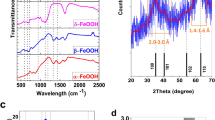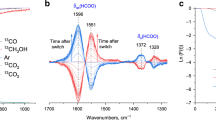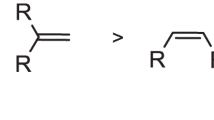Abstract
IT is frequently stated that the intense activity of certain metallic compounds as oxidation catalysts is a matter of great technological interest and that knowledge of how these compounds react is still obscure in many details1. The foundations of a better understanding of the mechanism of metal ion catalysis were laid by Haber and Weiss2. The most notable recent advances in this field were made by C. E. H. Bawn3 and his school. It is now generally accepted that the aerobic oxidation of linoleic acid and its esters proceeds through a chain reaction with the free radicals R· and RO2
˙ as chain carriers, namely:  The most difficult aspect is the initial production of free radicals. It is this aspect which is most directly related to metal catalysis. The following heavy-metal stearates were prepared and their catalytic effect examined: cupric, ferric, (partially oxidized) ferrous, cobaltous, manganous, cerous, vanadyl, thallous and stannous stearates. The latter two were investigated with the object of determining whether two-electron transfer would be more efficient than one-electron transfer in the initiation process. In the polar solvents ethyl alcohol, ethyl acetate and ethyl caprylate, none of the heavy metal stearates had any appreciable catalytic activity at 25° C., approximately 0.1 M methyl linoleate (or linoleic acid) and a catalyst concentration equal to or less than M/5,000. In dilute benzene solutions, cobaltous, manganous and cerous stearates were the only active catalysts leading to hydroperoxide formation. At a catalyst concentration of iM/5,000, 25° C. and 0.1 M methyl linoleate, the rates of formation of hydroperoxide were approximately seven, five and four milliequivalents methyl linoleate hydroperoxide per mole methyl linoleate per hour with cobaltous, manganous and cerous stearate, respectively. Cupric stearate did not catalyse the formation of hydroperoxide but appeared to be an active catalyst in its decomposition into unsaturated aldehydes and ketones. The activation energy of hydroperoxide formation catalysed by cobaltous stearate was determined as 20 k.cal.
The most difficult aspect is the initial production of free radicals. It is this aspect which is most directly related to metal catalysis. The following heavy-metal stearates were prepared and their catalytic effect examined: cupric, ferric, (partially oxidized) ferrous, cobaltous, manganous, cerous, vanadyl, thallous and stannous stearates. The latter two were investigated with the object of determining whether two-electron transfer would be more efficient than one-electron transfer in the initiation process. In the polar solvents ethyl alcohol, ethyl acetate and ethyl caprylate, none of the heavy metal stearates had any appreciable catalytic activity at 25° C., approximately 0.1 M methyl linoleate (or linoleic acid) and a catalyst concentration equal to or less than M/5,000. In dilute benzene solutions, cobaltous, manganous and cerous stearates were the only active catalysts leading to hydroperoxide formation. At a catalyst concentration of iM/5,000, 25° C. and 0.1 M methyl linoleate, the rates of formation of hydroperoxide were approximately seven, five and four milliequivalents methyl linoleate hydroperoxide per mole methyl linoleate per hour with cobaltous, manganous and cerous stearate, respectively. Cupric stearate did not catalyse the formation of hydroperoxide but appeared to be an active catalyst in its decomposition into unsaturated aldehydes and ketones. The activation energy of hydroperoxide formation catalysed by cobaltous stearate was determined as 20 k.cal.
This is a preview of subscription content, access via your institution
Access options
Subscribe to this journal
Receive 51 print issues and online access
$199.00 per year
only $3.90 per issue
Buy this article
- Purchase on Springer Link
- Instant access to full article PDF
Prices may be subject to local taxes which are calculated during checkout
Similar content being viewed by others
References
Bateman, L., Quart. Revs. Chem. Soc., 8, 147 (1954).
Haber and Weiss, J., Proc. Roy. Soc., A, 147, 332 (1934).
Bawn, C. E. H., Discuss. Farad. Soc., 14, 181 (1953).
Uri, N., Chem. Revs., 20, 375 (1952).
Weiss, J., Experientia, 9, 61 (1953).
George, P., J. Chem. Soc., 4349 (1954).
Author information
Authors and Affiliations
Rights and permissions
About this article
Cite this article
URI, N. Metal Ion Catalysis and Polarity of Environment in the Aerobic Oxidation of Unsaturated Fatty Acids. Nature 177, 1177–1178 (1956). https://doi.org/10.1038/1771177a0
Issue Date:
DOI: https://doi.org/10.1038/1771177a0
This article is cited by
-
Effect of water activity on secondary products formation in autoxidizing methyl linoleate
Journal of the American Oil Chemists' Society (1992)
-
Inhibitory effects of some natural products on metal-induced lipid oxidation in cooked fish
Biological Trace Element Research (1992)
-
The inhibitory effect of water on the Co2+ and Cu2+ catalyzed decomposition of methyl linoleate hydroperoxides
Lipids (1992)
-
Effect of experimental factors on the prooxidant behavior of α‐tocopherol
Journal of the American Oil Chemists' Society (1980)
-
Linoleic acid oxidation catalyzed by various amino acids and cupric ions in aqueous media
Journal of the American Oil Chemists' Society (1978)
Comments
By submitting a comment you agree to abide by our Terms and Community Guidelines. If you find something abusive or that does not comply with our terms or guidelines please flag it as inappropriate.



